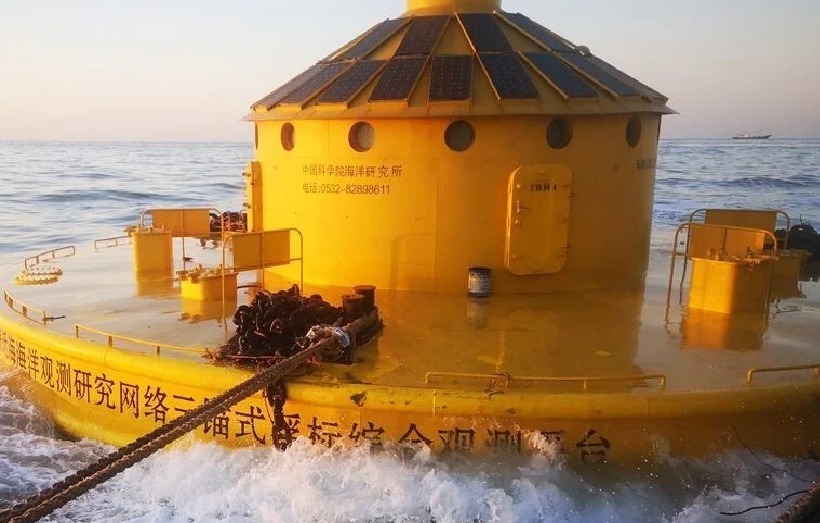Tokyo has revealed that China placed a buoy on the high seas above Japan’s southern continental shelf in the Pacific Ocean. This comes after Beijing was accused of launching spy balloons over the US, Japan, and India for covert operations.
>>China Now “Owns A Country”, Literally! Expert Says There Is No Other Nation With A Higher Debt Exposure Than Laos
Japan’s Chief Cabinet Secretary, Yoshimasa Hayashi, expressed anguish at a news conference, stating that China had set up a small buoy in the waters off Japan’s western main island of Shikoku and north of the southernmost Okinotori Island “without explaining its purpose and other details.”
Hayashi added that the Japanese government has urged China not to undermine Japan’s maritime interests. In response, Beijing claimed that the buoy was installed to monitor tsunamis and did not intend to infringe upon Japan’s sovereignty over the continental shelf.
He added that the Japanese government was continuing to gather and analyze relevant information to better understand the situation.
The buoy was set up in mid-June by the Chinese survey ship Xiang Yang Hong 22, which was being monitored by Japanese authorities as it sailed through Japan’s exclusive economic zone (EEZ) in the East China Sea.
The area in question is surrounded by Japan’s EEZ, adding to its sensitivity. Tokyo has long been worried about the increasing operations of the Chinese military near its territorial boundaries.
In particular, China’s rising military activities and maritime assertiveness in regional waters have been a point of contention. Japan has frequently protested against repeated intrusions by Chinese ships into Japanese waters around the Senkaku Islands, which Beijing calls Diaoyu.
This incident is not an isolated one. Last July, Beijing installed another buoy inside Japan’s EEZ near the Tokyo-controlled, Beijing-claimed uninhabited Senkaku Islands in the East China Sea, prompting Tokyo to protest.
Japan has demanded the immediate removal of the buoy at various summits and foreign ministerial meetings between Japan and China. However, China has yet to respond to these requests.
Why Is Japan Alarmed?
China’s recent installation of a buoy in Japan’s Pacific Ocean jurisdiction, specifically the Shikoku Basin region, marks a major development in the ongoing maritime tension between the two nations.
China’s decision to deploy buoys in new locations is uncommon, as they have traditionally placed them mainly in the East China Sea, including near the Senkaku Islands in Okinawa Prefecture.
The buoy, deployed by the Chinese vessel Xiang Yang Hong 22, reportedly gathers wave and other data, which is then transmitted to China via satellites.
Departing from Shanghai on June 5, the vessel navigated through the Osumi Strait off Kagoshima Prefecture to reach the Pacific Ocean. By mid-June, it had positioned a small buoy in the Shikoku Basin region.
This buoy, equipped with a light-emitting device visible to passing ships at night, is smaller than one previously installed in July 2023.

The Shikoku Basin, an area nearly half the size of Japan (378,000 square kilometers), falls entirely within Japan’s Exclusive Economic Zone (EEZ).
Despite the absence of nearby islands, the UN Commission on the Limits of the Continental Shelf (CLCS) recognized it as Japan’s continental shelf in 2012, with Okinotorishima Island as its base point.
Under the UN Convention on the Law of the Sea, Japan exercises sovereign rights over the continental shelf, allowing for seabed exploration and resource exploitation.
While oceanographic surveys in continental shelf waters do not need approval from coastal states, issues may arise if the buoy is connected to seabed exploration or similar activities, potentially breaching the UN convention, particularly regarding mineral resources such as rare metals thought to exist in the seabed.
On the other hand, China disputes Japan’s EEZ and continental shelf claims based on Okinotorishima, arguing it is a rock, not an island.
China has conducted oceanographic surveys and military exercises in the western Pacific, near Okinotorishima, prompting concerns that China could install buoys in Japan’s Pacific EEZ akin to those in the East China Sea. As a result, Japan has escalated vigilance and surveillance efforts in the region.
The concerns regarding China’s recent buoy installation in Japan’s Pacific Ocean jurisdiction are well-founded, particularly in light of Beijing’s past actions in other disputed maritime regions.

In the South China Sea, where China is embroiled in territorial disputes with countries like the Philippines, buoys have frequently been used as a tool to assert control and reinforce claims over contested areas.
For instance, in 2011, the Philippines accused China of installing a buoy and conducting construction activities near Iroquois Reef and Amy Douglas Bank.
In 2015, the Philippine Navy discovered Chinese buoys at Amy Douglas Bank and later by Filipino fishermen at Scarborough Shoal, who towed them back to shore.
In the East China Sea, China installed a 15-meter-wide buoy in 2021 as part of an extensive network of over 27 buoys initiated in 2014. These buoys gather data for what China terms “rights protection,” effectively asserting Chinese sovereignty in disputed maritime territories.
These precedents highlight the potential for the recently installed buoy in the Shikoku Basin to be part of China’s broader strategy to solidify its claims in disputed maritime regions.
- Contact the author at ashishmichel(at)gmail.com
- Follow EurAsian Times on Google News




